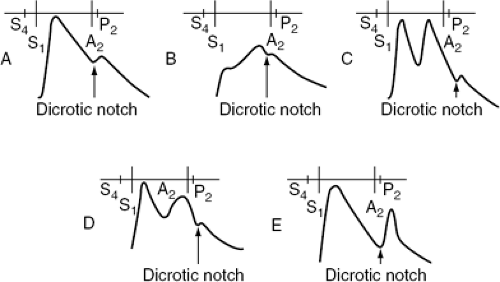The bisferiens (from the Latin, meaning 'twice beating') pulse has a waveform characterized by two positive waves during systole (see Fig. 10-42B). The pulse wave upstroke rises rapidly and forcefully, producing the first systolic peak (percussion wave). A brief decline in pressure is followed by a smaller and somewhat slower-rising positive pulse wave (tidal wave). Abnormalities of LV ejection and reflected waves from peripheral arteries contribute to the prominence of the second systolic wave in the bisferiens pulse. The bisferiens pulse, usually felt in the carotid artery, is sometimes more easily palpable in a brachial or radial artery. A bisferiens pulse often occurs in patients with pure aortic regurgitation and in patients with combined aortic stenosis and severe aortic regurgitation.182 It also can occur in other conditions associated with the rapid ejection of an increased stroke volume from the left ventricle (e.g., exercise, fever, patent ductus arteriosus).
- Bifid Carotid Pulse
- Bisferiens Pulse Pda
- Bisferiens Pulse In Aortic Regurgitation
- Bifid And Bisferiens Pulse
- What Is Bisferiens Pulse
- Bisferiens Pulse Is Characteristically Found In
- Bisferiens Pulse Pronounce

The bisferiens pulse often is present in patients with hypertrophic cardiomyopathy, many of whom have a pressure gradient in the LV outflow tract.183 In this syndrome, the midsystolic negative wave usually coincides with a marked decrease in the rate of LV ejection. The second systolic wave, or tidal wave, most likely is produced by reflected waves from the periphery. The bisferiens pulse may be elicited by maneuvers that decrease the LV size or increase its contractility. The most characteristic aspect of the arterial pulse in hypertrophic cardiomyopathy is its rapid rate of rise. A physical finding nearly specific for hypertrophic cardiomyopathy is a much smaller arterial pressure pulse in the cardiac cycle following a premature ventricular beat (see Chap. 67).
Continue reading here: Parvus Et Tardus Pulse
Pulsus bisferiens or double pulse refers to a wave pattern where there is the presence of two systolic peaks that can be seen in pressure tracings of the the ascending aorta, the aortic arch, and the carotid artery. It can occur in patients with. Aortic valve pathology: aortic regurgitation with. Collapsing or water hammer pulse with rapid upstroke & descent characteristically occurs n aortic regurgitation. Bisferiens pulse: this is a combination of low rising & collapsing pulses occurring when aortic stenosis & incompetence are present. homeobook.com Gastrointestinal. Join this channel to get access to perks:on instagram:- https://www.instagram.com/drgbha. Pulsus bisferiens is a feature of severe aortic regurgitation. It shows two upstrokes of arterial pressure trace during systole and wide pulse pressure may concomitantly be present. 1 A similar waveform may also be visible in hypertrophic obstructive cardiomyopathy, severe mitral valve prolapse, and sepsis. Pulsus bisferiens is a high volume double-beating pulse which has single pulse wave with two peaks in systole.It is best palpated In large arteries like brachial and carotid arteries. The first lift is due to P wave (percussion wave) and the second lift is due to T or tidal wave. It is said that if the PT.

Was this article helpful?
Bifid Carotid Pulse
Bisferiens Pulse Pda
Pulsus bigeminus is a cardiovascular phenomenon characterized by groups of two heartbeats close together followed by a longer pause. The second pulse is weaker than the first. Look for a pattern of what appears to be a relatively normal QRS complexes, each followed by a smaller, abnormal one. The smaller beat is palpated as either a missing or an extra beat, and on EKG resembles a PVC.[1] These PVCs appearing every other beat are also called extrasystoles.
This phenomenon can be a sign of hypertrophic obstructive cardiomyopathy or of many other types of heart disease (see list below). Other causes include digitalis toxicity, induction of anesthesia,[2] placement of surgical instrumentation into the thorax or as a benign, temporary phenomenon.
In Pulsus Bigeminus not all of the conducted electrical activity will elicit sufficient ventricular contraction to produce a palpable pulse. This is important for two reasons. One, an ECG may give a ventricular contraction rate that does not correspond to the palpated pulse rate. Secondly, because not all beats are being conducted, patients may present with symptoms of low output heart failure, e.g. Dizziness, shortness of breath or hypotension, even with a normal ECG.
Cause[edit]
Causes Include:
Bisferiens Pulse In Aortic Regurgitation
- Electrolyte imbalance e.g. Hypo or hyperkalemia
- Betablocker therapy
- Destruction or degeneration of the cardiac conduction system or heart muscle cells
- Infection
A doctor can discriminate pulsus bigeminus from pulsus alternans by auscultating the heart.
Bifid And Bisferiens Pulse
Management[edit]
Management includes looking for and removing underlying cause, including medicines (such as a Calcium Channel blocker) and inotropic therapy to return cardiac output back to normal. If highly symptomatic over a longer period ablation therapy may be the only viable option.
See also[edit]
What Is Bisferiens Pulse
References[edit]
- ^Anand, Nidhi; Manish Anand; Alok Vardhan Mathur; Madhukar Maletha; SK Ghildyal (2010-02-03). 'Intra-operative ventricular bigeminy: Can retractor be a cause'. Journal of Anaesthesiology Clinical Pharmacology. 26 (4): 569–570. Retrieved 2012-05-16.
- ^ROLLASON, WN; D. J. HALL (March 1973). 'Dysrhythmias during inhalational anaesthesia for oral surgery'. Anaesthesia. 28 (2): 139–145. doi:10.1111/j.1365-2044.1973.tb00305.x.
Bisferiens Pulse Is Characteristically Found In
Bisferiens Pulse Pronounce
